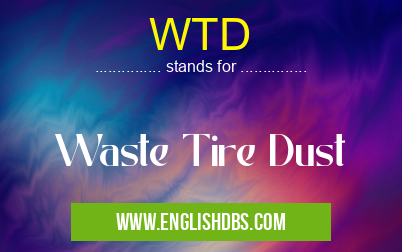What does WTD mean in UNCLASSIFIED
WTD stands for Waste Tire Dust, which refers to the fine particles produced when scrap tires are processed. It is a byproduct of tire recycling and poses environmental and health concerns.

WTD meaning in Unclassified in Miscellaneous
WTD mostly used in an acronym Unclassified in Category Miscellaneous that means Waste Tire Dust
Shorthand: WTD,
Full Form: Waste Tire Dust
For more information of "Waste Tire Dust", see the section below.
What is WTD?
WTD is composed of various materials, including rubber, steel, and textile fibers. During tire recycling, tires are shredded into small pieces, generating dust particles that can range from 1 to 500 microns in size. WTD is highly combustible and can self-ignite, releasing toxic fumes that include polycyclic aromatic hydrocarbons (PAHs), carbon monoxide, and fine particulate matter.
Environmental Concerns
WTD poses significant environmental risks. Its accumulation in landfills and open dumpsites can lead to:
- Air pollution: Dust particles can become airborne, contributing to air pollution and respiratory problems in nearby communities.
- Water contamination: WTD can leach harmful chemicals into groundwater and surface water, contaminating water sources.
- Fire hazards: WTD is highly combustible, increasing the risk of fires in landfills and recycling facilities.
Health Concerns
Exposure to WTD can have adverse health effects:
- Respiratory issues: Dust particles can irritate the lungs, leading to respiratory problems such as asthma and bronchitis.
- Cancer risks: PAHs released from WTD burning are known carcinogens, increasing the risk of cancer.
- Neurological effects: Exposure to WTD has been linked to neurological effects, including cognitive impairment and developmental disorders.
Essential Questions and Answers on Waste Tire Dust in "MISCELLANEOUS»UNFILED"
What is Waste Tire Dust (WTD)?
Waste Tire Dust is a fine, particulate material created when tires are shredded or ground into smaller pieces. It typically consists of rubber, steel, and fabric components and can pose potential environmental and health concerns.
What are the potential hazards associated with WTD?
WTD can release hazardous chemicals, such as polycyclic aromatic hydrocarbons (PAHs), into the environment. These chemicals have been linked to various health risks, including cancer, reproductive issues, and respiratory problems. Additionally, WTD can contribute to air pollution and water contamination.
How is WTD managed and disposed of?
Proper management of WTD involves collecting and processing it in an environmentally friendly manner. This can include reuse or recycling of the material for various applications, such as road construction or rubber products. Landfilling is also an option, but it is important to ensure proper containment and monitoring to minimize potential risks.
What regulations are in place to control WTD?
In many jurisdictions, regulations exist to control the management and disposal of WTD. These regulations may vary by region and typically aim to minimize the release of hazardous chemicals into the environment, promote responsible disposal practices, and protect public health.
What can individuals do to reduce WTD?
Individuals can contribute to reducing WTD by practicing proper tire maintenance and disposal. This includes regularly inflating tires to maintain optimal pressure, extending tire life by rotating and balancing them, and recycling tires at designated recycling facilities. By reducing tire wear and discarding tires responsibly, individuals can help minimize the generation of WTD.
Final Words: WTD is a hazardous byproduct of tire recycling that poses environmental and health risks. Proper management and disposal of WTD are crucial to mitigate these risks. Regulations and programs aim to control WTD generation, promote responsible recycling, and protect human health and the environment.
WTD also stands for: |
|
| All stands for WTD |
